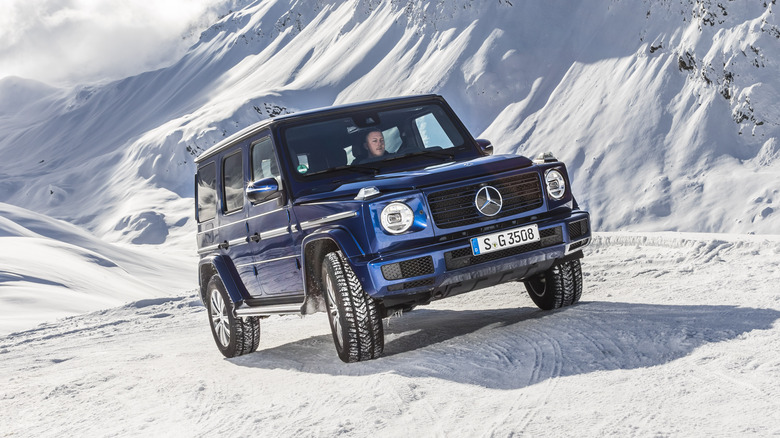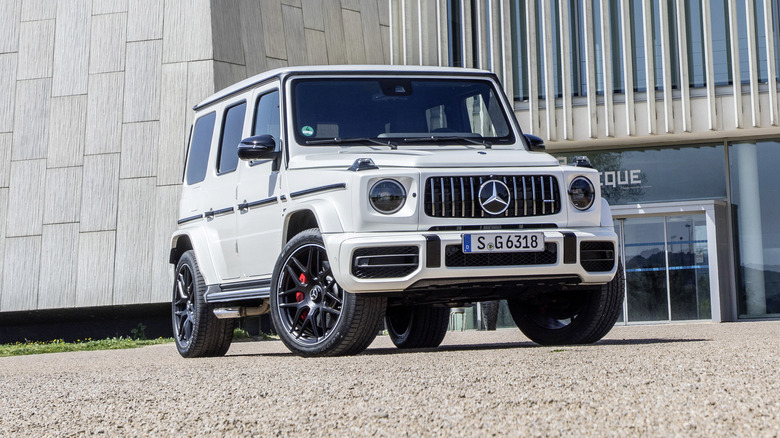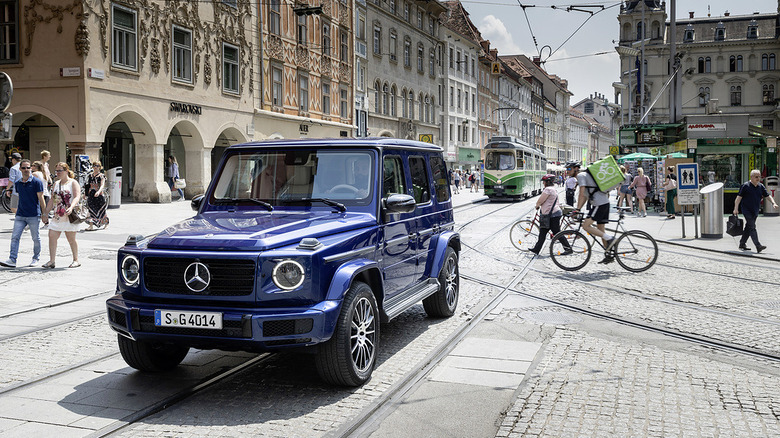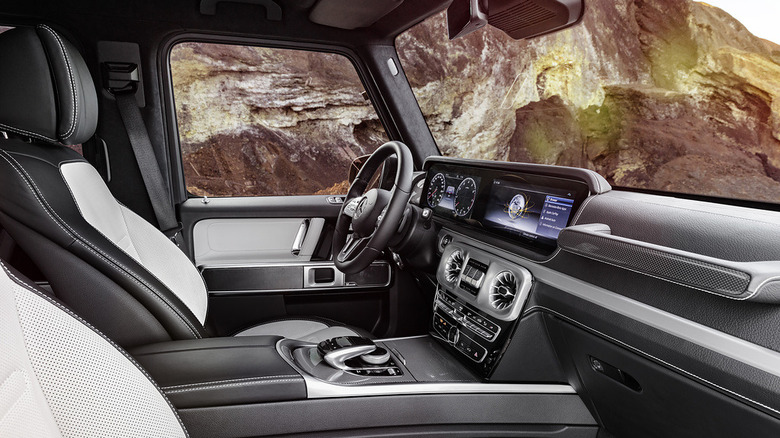10 Reasons Why The Mercedes G Wagon Is Such An Expensive Vehicle
Developed as a partnership between Daimler, Steyr, and Puch, the original Geländewagen made its debut in 1979, and it's been in production ever since. Initially, the G-Wagon was built with military customers in mind, but as a result of its unbeatable reliability and class-leading all-terrain capabilities, it became popular with everyone from mountain rescue teams to wealthy farmers. In recent years, it's become more closely associated with the streets of Hollywood than the farms of Germany, but it still retains its off-road chops, even if most owners will never use it off the tarmac.
Even with its reputation as one of the toughest yet most luxurious SUVs on the market, there's no getting away from just how pricey the G-Wagon is. The base-spec G550 model starts at $139,900 for 2022, while the AMG G63 will cost at least $179,000. Take into account that this is for the base models only without extras, and a fully-specced AMG G-Class will set buyers back close to $200,000. That puts it firmly out of the reach of most of us, but there are plenty of reasons why deep-pocketed buyers are happy to cough up the cash for one.
A distinguished history
Like many of the world's best off-road cars, the G-Wagon was originally designed to be a military vehicle. One of the earliest big orders for the car came from the Shah of Iran, who requested 20,000 units, but was deposed before the contract could be completed (via Retromotor). It didn't matter too much to Mercedes though, as most of those initial units instead went to the Swiss, Norwegian, and Argentinian armies. Germany's local police forces were also among the G-Wagon's earliest customers, and before long, it became clear that there was plenty of interest in a civilian version of the vehicle too.
The main reason the G-Class was so hotly in demand was its ability to cross all types of terrain with ease, a result of the five-year testing regimen the car's engineers had subjected it to. During development, the G-Wagon had been put through its paces across German coalfields, salt lakes in the Sahara, and snowy trails in the Arctic Circle. Each new environment gave engineers further opportunity to fine-tune the car, and the result was a vehicle that was capable across almost any terrain.
Class-leading all-terrain capabilities
Over its 40-plus years of production, the G-Wagon has evolved a long way from its initial military roots. The original generation of the car continued production until 2018, when a second-generation G-Class was launched that, despite looking similar to its predecessor, was all-new underneath. What hadn't changed, however, was its ability to conquer almost any terrain. Several versions of the G-Class are currently available with different markets in mind, but for buyers who want maximum off-road capability, the Professional Line Package is the way to go.
Adding this package unlocks a suite of trail-ready extras, including stone guard grilles for the headlights, mud flaps, a roof rack, and chunky off-road tires. Mercedes-Benz's Manufaktur Customization Program also allows buyers to option from almost any accessories they'd like, with gear like a rear-mounted spare tire holder available for drivers looking to take their G-Wagon over the most punishing terrain. While it's difficult to say that any SUV is definitively the top off-roader out there, it's safe to say that the G-Wagon is one of the most capable SUVs on the market right now.
Unwavering reliability
The G-Wagon isn't just very capable off-road, it's also very reliable, as ex-pilot Gunther Holtorf proved when he took 'Otto', his 1988 G-Class, on a 559,000 mile trip across 215 countries. The entire trip lasted 24 years, from 1990 to 2014, and saw Holtorf drive through usually-forbidden territories including North Korea, Myanmar, and 15,000 miles across China. He did this with a full suite of spare parts, food, water, and emergency supplies, meaning Otto was usually carrying around 1,100 lbs more than its permissible gross vehicle weight load.
The only modifications made to the vehicle were reinforced springs and shock absorbers, with everything else remaining completely stock. In an interview, Holtorf confirmed that the axles, engine, and transmission were all still original, with the body and frame showing no signs of fatigue. After completing its 24-year global odyssey, Otto can now be found in the Mercedes-Benz Museum in the manufacturer's home city of Stuttgart, Germany.
Powerful AMG variants
On the other side of the SUV spectrum from Otto's long-distance heroics, Mercedes-Benz's AMG G-Classes prove that the car makes for a surprisingly rapid performance vehicle if it's given enough horses under the hood. The G63 AMG can sprint from 0-60 mph in just 4.4 seconds, and with the optional Drivers' Package, will top out at 149 mph. Not bad for something that has the aerodynamics of a flying brick. To keep it smooth at speed, the AMG gets adaptive adjustable damping as standard, with four driving modes available to choose from including Comfort, Slippery, Sport, and Sport+.
In Sport and Sport+, there's a dual-clutch function that drops the SUV to the lowest possible gear when the accelerator is floored, providing an instant torque boost that's useful for overtaking cars on narrow roads. Even with the focus on performance though, the AMG G63 is still highly capable on rough roads, with our reviewer reporting that even as a passenger over a challenging off-road course, the G-Wagon remained surprisingly comfortable.
As safe as it is capable
Tackling off-road courses or testing the G-Wagon's top speed is great on occasion, but the reality is that most examples of the car will spend the majority of their working lives stuck in city traffic or crawling along a congested freeway. For those urbanite owners, Mercedes-Benz offers a range of useful safety features that should bring extra peace of mind (albeit for an extra cost via Autoblog). Adaptive Cruise Control can be optioned, alongside blind-spot monitors, active parking assist, and a full surround-view camera system. Automatic emergency braking is also included as standard.
Airbags are equipped at the front, side, and roof of the car, alongside knee airbags to protect drivers and passengers from impact with the dash. In addition to all those safety features, of course, is the tough construction of the car itself, with its ladder frame constructed of sheet steel that's up to 3.4mm (0.13 inches) thick in places.
Luxurious interiors
While they're crawling through Los Angeles traffic (or traversing a rocky trail, as the case may be), G-Class owners can relax in an interior that's just as luxurious as Mercedes-Benz's flagship S-Class sedan. There's plenty of leather, wood, and polished metal trim on offer, and much like every other aspect of the SUV, even more lavish materials can be added at an extra cost (via Carbuzz). Both the G550 and the G63 AMG share the same standard interior, with two 12.3-inch screens dominating the driver's view. One acts as a digital gauge cluster, and the other an infotainment system, with the latter being a touchscreen.
If the standard cabin isn't quite fancy enough, there are a variety of optional extra packages available for the most demanding buyers. Additional interior color combinations like Classic Red/Black are unlocked by selecting the $5,000 Exclusive Interior package, which also adds Nappa leather and a Dinamica headliner to the cabin (via CarBuzz). Alternatively, the Exclusive Interior Plus package adds all those upgrades plus extras like velour floor mats and a frameless rear-view mirror. Opting for some custom Manufaktur elements will push the price up even further, with AMG Carbon Fiber trim alone costing $3,700 according to CarBuzz.
Plenty of aftermarket options
If nothing that Mercedes-Benz can offer is unique enough, then buyers can always turn to aftermarket companies to create a G-Wagon that's rarer, pricier, and often more... polarizing to look at. The G-Wagon aftermarket is huge, with leading tuners like Brabus and Mansory each having several packages to choose from. As well as overhauling the car's interior and adding body kits, these tuners will usually also upgrade the engine to put out significantly more power than stock. The Brabus 800 Black & Gold Edition, for example, can produce up to 800 horsepower and 738 lb-ft (1,000 nm) of torque.
Visually, the Black & Gold Edition gains a Widestar body kit, various carbon fiber elements, and 23-inch monoblock forged wheels, alongside a revamped leather interior. It's over-the-top, but that's exactly the point, as it gives owners the chance to stand out, even among a crowd of other G-Classes. While the tastefulness of many of these kits can be debated, their ability to generate a reaction from onlookers is indisputable. For some owners, that's all that matters.
Popular with celebrities
The G-Class has only officially been sold in America since 2002, but it's quickly become a hit among the Hollywood elite, with the likes of Justin Bieber and Pete Davidson among the laundry list of owners. Keeping the G-Class fashionable among America's wealthy trendsetters has allowed Mercedes-Benz to focus on the upper end of the SUV's price spectrum, as each new owner naturally wants their G-Wagon to be faster and more luxurious than the last celeb. This applies to other markets around the world too –- while Royal family members like Queen Rania of Jordan, pictured above, aren't "celebrities" in the traditional sense, their trendsetting abilities across the Middle East have ensured that the G-Wagon remains a favorite throughout the region.
Of course, not every piece of celebrity-related G-Wagon news is positive. There are plenty of tales of celebs crashing their expensive SUVs, and singer Sean Kingston even had his car repossessed since he didn't keep up the lease payments. On the whole, it's a net positive for Mercedes-Benz to keep their car so closely associated with the country's rich and famous if nothing else because they're willing (and able) to spend much higher sums on their vehicles than the average premium SUV buyer.
There isn't much competition
Most luxury SUVs would complain almost as soon as they're taken off the asphalt, and most high-end versions of traditional off-roaders could best be described as "premium" rather than being truly luxurious inside. The G-Class offers both high-level luxury and trail-ready off-road capabilities, and that's a combination that remains pretty unique even with today's booming SUV market. While it could be argued that a Range Rover is still decently competent off-road, it isn't in the same league as the G-Class, and that's about the closest the Mercedes gets to having direct competition.
Add in the prestige of a tri-star badge on the front, and the G-Class sits in a segment all of its own. It's worth noting that although most buyers won't ever use the G-Wagon off-road, it's the car's potential utility that makes it desirable among rich city dwellers. It's the same mentality that leads wealthy urbanites to buy supercars, then never drive them apart from taking them to occasional cars and coffee events. While a slower, less powerful car would do an equally good job, it wouldn't have the potential to do more, and that's what gives owners bragging rights. There's simply no other luxury SUV on the market that gives owners as many all-terrain bragging rights as a well-specced G-Class.
An electric model is in development
The second-generation G-Class might have only launched in 2018, but Mercedes-Benz already has plans for a new, electric version to bring the model in line with the rest of the brand's electrification plans. The news was originally confirmed back in 2019, and despite the pandemic and global chip shortage, Mercedes has remained committed to launching the EQG, as it will be known, in 2024. It should go without saying that developing an all-new electric version of any car is a costly endeavor, but the G-Class may be more difficult than most. This is primarily down to its aerodynamics, or rather, the total lack of them.
The iconic boxy shape of the G-Wagon has become a key part of the SUV's appeal, and deviating from the design too radically is out of the question for the brand. The EQG dutifully keeps the original G-Class' upright shape intact, but it remains to be seen about the effect this has on the car's range. In general, the slipperier the design of the car, the more range it will be able to squeeze out of its battery pack. Mercedes is well aware of this, which is why the recently-launched EQC and EQS all have very smooth, flowing lines, for a low drag coefficient. The G-Class is about as slippery as a strip of velcro, so it remains to be seen what technical wizardry Mercedes' engineers will employ to keep it on par with its gas-powered sibling.










